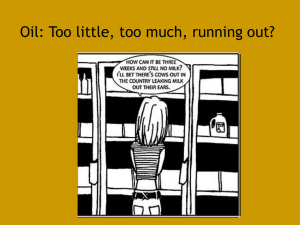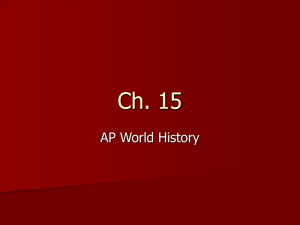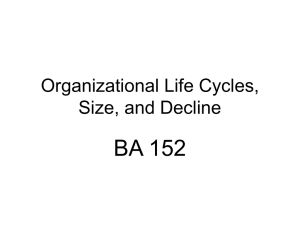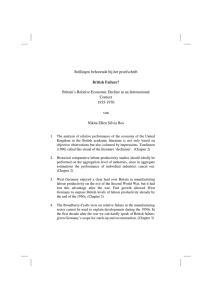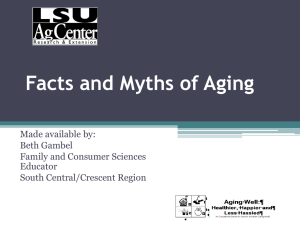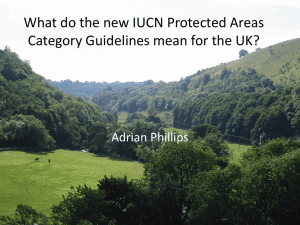Biological recording and the drivers of change in freshwater – Dr
advertisement
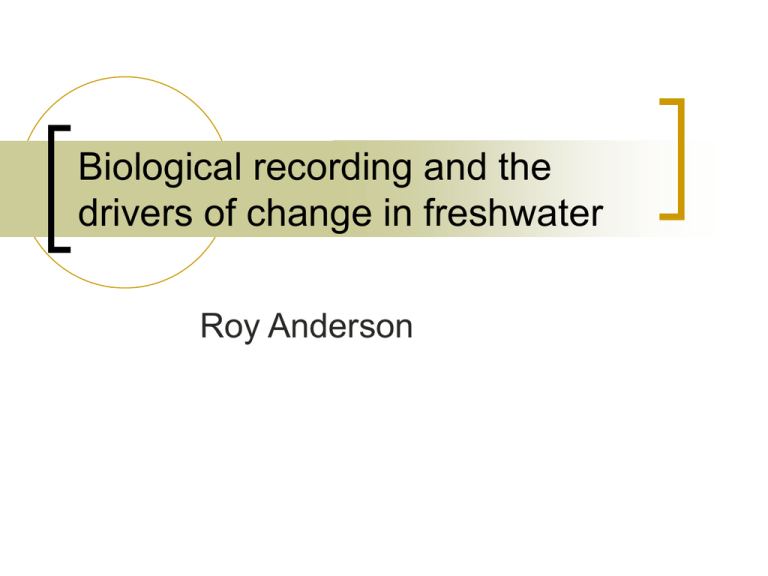
Biological recording and the drivers of change in freshwater Roy Anderson Objectives Red list aquatic invertebrates to: Improve knowledge of Faunal composition Habitat association Change over time Strategy Mapping schemes Require some public participation Guided by a body of dedicated people driving and co-ordinating/validating Ideally with regular updates via websites Eventually, publication of atlases Outcome Mapping schemes Red Lists The Red Listing process should: Obtain and encode all historical data Compare with modern results Be subject to periodic update as new data becomes available Classify fauna according to IUCN guidelines and register level of threat Draw in available habitat, climate and water quality data to compare with faunal distribution and relate to perceived changes in that distribution Adephaga Aquatic and semi-aquatic Adephaga Red List published in 2009 244 taxa recorded belonging to 16 families, both fully aquatic and marginal; 73 red-listed i.e. 30% Measuring change Data from early twentieth century compared with recent data to determine change in status Regional extinction risk A – past, present or future population decline B – restricted range, fragmentation, continuing decline C – small population size and continuing decline D – very small populations in decline Evaluation Only a small minority of the declining species were considered to be in a general population decline i.e. a decline across the country by comparing distribution pre and post 1980 (category A2) The vast majority of highly threatened species were considered a priori to have fragmented ranges or specific requirements (stenotopy) which was related to decline (category B2) A large number placed in a lower threat category (VU) were considered at risk because of the small population size or limited number of available sites (category D2) A similar number were also classed as near threatened (category A3) because of more general decline, but related to reliance on a specific habitat Many species associated with fen habitats showed little real evidence of decline but were classified as at high risk because of findings outside Ireland The habitat with most at risk species was fen (next slide) but few fen species actually show a decline in Ireland! Habitat associated decline Siltation - river gravels/lakeshores Also here: Enicocerus exsculptus, Bidessus minutissimus, Hygrotus novemlineatus (? diffuse pollution) Drainage - brackish habitats - lagoons Also here: Ochthebius marinus, Haliplus apicalis, Helophorus fulgidicollis, Enochrus halophilus Warming - montane sites and species Also here: Dytiscus lapponicus. Stictotarsus multilineatus, Agabus arcticus Mollusca Measuring change Red List published in 2009 150 total native spp of which 53 are red-listed: i.e. 35% 79 aquatic of which 31 are red-listed i.e. 39% Regional extinction risk A – past, present or future population decline B – restricted range, fragmentation, continuing decline C – small population size and continuing decline D – very small populations in decline Evaluation Very different from Adephaga Risk seems to have its greatest concentration in category A suggesting general decline rather than association with rare habitats (stenotopy) or having a previously fragmented range This suggests that an important environmental variable has changed recently and is affecting many species Examples Eutrophication/diffuse pollution Myxas glutinosa Glutinous snail IUCN Endangered A2c A declining species across its entire west palaearctic range. Ireland is now its headquarters with up to 50% of global population. Needs gently flowing, low-P calcareous waters. Also here: Omphiscola glabra, Anisus vortex, Radix auricularia, Margaritifera margaritifera, Pisidium lilljeborgii, P. pulchellum, P. moitessierianum Pre-1980 Post-1980 Drainage and Eutrophication Pre-1980 Omphiscola glabra Mud snail [IUCN Extinct ] – Critically endangered A declining species across most of Europe. Confined to the south-east, and recently re-discovered at a site in Co Waterford. Requires low-P poor fen or undrained low-nutrient riverine marshes Post-1980 Drainage – freshwater marshes, floodplains Pre-1980 Aplexa hypnorum Moss bladder snail IUCN Vulnerable A2c Widespread Palaearctic species living in temporary habitats, especially on winter-flooding lakeshores and riverbanks. Declining thro’ habitat destruction Also here: Quickella arenaria, Succinella oblonga, Vertigo antivertigo, V. moulinsiana, Musculium lacustre, Sphaerium nucleus Post-1980 Drainage - brackish habitats - lagoons Pre-1980 Hydrobia acuta neglecta Hydrobiid snail IUCN Endangered B2a,b(iii,iv) A north European endemic. Confined to coastal lagoons of high salinity. Four known sites, two of which have recently been destroyed by drainage/changes in management. Also here: Ventrosia ventrosa, Truncatella subcylindrica, Mercuria cf. similis Post-1980 Warming - montane sites and species Pisidium conventus Arctic-alpine pea mussel IUCN Critically Endangered B2ab(i,ii,iii,iv) Boreal relict, probably in steep decline. Only one recent site. Conclusions Drivers of change Both Coleoptera and molluscs suffer from diffuse pollution via its effects on algal growth, de-oxygenation etc. This reaction appears more restrained in Coleoptera which are threatened more by range fragmentation and destruction of specific fen and peatland types Molluscs are possibly unable to escape the effects of diffuse pollution because they and are less mobile and have a more permeable integument May be good indicators of pollution, both point source & diffuse Beetles may be more useful in assessing the decline of specific habitats Brackish habitats home to both groups continue to decline and pose a threat to many stenotopic species Warming affects only one mollusc but a number of beetles

